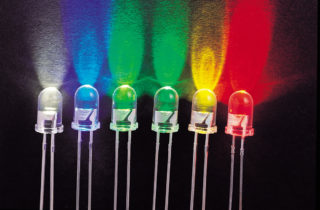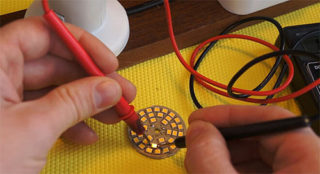Initially, LEDs were used as indicators or in small devices. For example, in garlands or switches as a backlight. Modern appliances are able to completely replace conventional lamps in home, outdoor, industrial, and office environments. To make the best choice, you need to familiarize yourself with the main points before buying.
Classification of LEDs by their field of application
LED lighting elements vary in their field of application. The main types of LEDs: indicator and lighting. Devices are not the same, each has its own distinctive features and technical parameters.
Indicator LEDs
The first LED lamp appeared in the middle of the last century. The device had a dull reddish glow, low energy efficiency. Despite the shortcomings, developments in this direction were continued. After 20 years, options with a yellow and green tint appeared. By the beginning of the 90s, the luminous flux reached 1 Lumen. By the beginning of the 2000s, the value reached the level of 100 Lumens.
In 1993, Japanese engineers introduced a blue LED. The light of the device has become much brighter than its predecessors. From that moment, devices with different glows began to appear on the market - a combination of blue, green, yellow and red allows you to create any color and shade.
Development is ongoing. New types of LEDs are appearing. At the same time, low-voltage consumption is maintained with an increase in the luminous flux.
LEDs
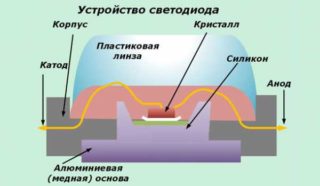 The first models with low luminosity (DIP) were suitable for indicator operation (for example, a switch is visible in the dark - a small red LED is on). Modern devices allow you to illuminate large areas - domestic and industrial premises. The power of the LED has increased - an LED device for a flashlight with a 3W indicator is similar to an incandescent lamp of 25-30W. Electricity consumption is about 10 times less.
The first models with low luminosity (DIP) were suitable for indicator operation (for example, a switch is visible in the dark - a small red LED is on). Modern devices allow you to illuminate large areas - domestic and industrial premises. The power of the LED has increased - an LED device for a flashlight with a 3W indicator is similar to an incandescent lamp of 25-30W. Electricity consumption is about 10 times less.
Such LEDs are called lighting due to the main scope. Used in tapes, headlights, lamps, other products. They are made in separate cases that allow surface mounting.
The main difference is that they give out only white light of a cold or warm hue. Classification:
- SMD - popular models with a diffusing element at 100-130 °; a substrate for a lamp made of copper or aluminum, do not heat up;
- SOW - more powerful, superbright, composed of many small crystals, the scattering angle is significant;
- Filament - have the lowest efficiency (in comparison with SMD), are often used as decorative elements, are made in various sizes and shapes.
Based on the purpose and parameters of the room, choose the best option. Characteristics of lighting devices are indicated on the packaging and in the technical documentation.
Advantages and disadvantages
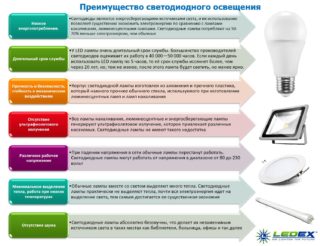 More and more users are striving to replace obsolete incandescent lamps with modern LED-lamp models. The main advantages of using LEDs:
More and more users are striving to replace obsolete incandescent lamps with modern LED-lamp models. The main advantages of using LEDs:
- energy saving without damage to the luminous flux of the lamp;
- durable materials of the case and internal elements: low probability of mechanical damage;
- long term of use: several times higher than a similar indicator of Ilyich bulbs;
- size: diodes are compact and quite mobile;
- high brightness;
- safety: the minimum voltage of the network is 3-24V.
Among the shortcomings note the high cost and the need for constant voltage. The price of products is gradually decreasing due to high customer demand.
Main characteristics
The technical parameters of the LEDs vary depending on the model. Common indicators are:
- current consumption;
- rated voltage (product voltage);
- power of consumed electricity (current-voltage graph);
- glow temperature;
- luminosity (level of a light stream).
There are other characteristics, but they are accessed in rare cases. For domestic use, it is enough to consider only these parameters of the LEDs.
LED consumption current
The indicator allows you to find out the amount of current consumed electrically by the device (LED). For devices with one active chip, 0.02A is sufficient. If the number is greater, the characteristic increases by a multiple of the number of elements. For this parameter, a resistor (stabilizer) is selected, which is installed on the input.
The stabilizer allows you to keep the device in working condition with voltage drops, regardless of the cause. Moreover - fluctuations in the current value of the LED changes the color temperature of the light from warm to brighter, colder. If the power surge is significant, without an additional resistor, the diode will burn instantly.
To choose the right stabilizer for current conversion, you can use a special online calculator.
Rated voltage
 The magnitude of the voltage is the amount of current in the output conductor. For the manufacture of LED-LEDs, different materials are used, the electrical characteristics of which directly affect the level of permissible voltage and color of lighting. Thanks to this dependence, you can find out what voltage specific LEDs are designed for, even “by eye”. For example, if the glow is yellow or red, the voltage is in the range of 1.9-2.5 volts, blue - about 3 volts.
The magnitude of the voltage is the amount of current in the output conductor. For the manufacture of LED-LEDs, different materials are used, the electrical characteristics of which directly affect the level of permissible voltage and color of lighting. Thanks to this dependence, you can find out what voltage specific LEDs are designed for, even “by eye”. For example, if the glow is yellow or red, the voltage is in the range of 1.9-2.5 volts, blue - about 3 volts.
Indicators of current and voltage of the LED should correspond. Otherwise, the diodes will either quickly burn out or will not give out light at the declared level.
To find out how many volts the LED is, you can use a multimeter or determine the color of the glow. For the first method, you need a multimeter and a resistor - a value appears on the display after assembly.
Light diode resistance
The total resistance depends on the electrical circuit into which the element is connected. The same LED may indicate a different value. For example, at the input - about 1 kΩ, at the output - several MΩ. However, resistance is not a linear characteristic. The indicator is inversely proportional to the voltage that is supplied to the mains. The higher the supply voltage of the LEDs, the lower the resistance level of the device.
Light output and angle of illumination
It is quite difficult to compare the light output of different lamps. For example, a 5 mm LED gives off light at 1-5 Lm, and an incandescent lamp at 70 W - 750 Lm. The dispersion angle is selected based on the area of the room. A diode of 30 ° is enough in the corridor, it is better to use elements of 90-120 ° or several at the same time in the room. The maximum angle of LED lights is 120 °. The most illuminated place is the center; light is scattered to the periphery.

LED lamp power
The power of the diode depends on several related indicators. For LEDs, the value ranges from 0.5 to 3 watts. It is calculated according to Ohm's law: it is necessary to multiply the values of current and voltage. The volt-ampere characteristic (CVC) of the LED is also determined.
The choice of the power supply unit of the device depends on the power level and CVC of the LED. Inappropriate elements may not be used - the lamps will burn out if the voltage and current supply are too high.
Colour temperature
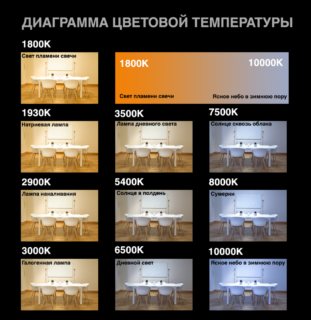 This indicator is similar to the characteristics of other lighting devices, especially to LED fluorescent devices. The temperature designation of the LED is indicated in K (Kelvins), sometimes on the packages there is a corresponding diagram - a scale on which the range is indicated in color. Matching light and meaning:
This indicator is similar to the characteristics of other lighting devices, especially to LED fluorescent devices. The temperature designation of the LED is indicated in K (Kelvins), sometimes on the packages there is a corresponding diagram - a scale on which the range is indicated in color. Matching light and meaning:
- 2700-3000 - warm, yellowish;
- 3500-4000 - daily, neutral;
- 5500-7000 - cold, with blue.
The main shades are presented. In practice, there are much more colors. The temperature is selected based on the purpose of the room, the required level of comfort and user preferences. For example, it is recommended to install lamps with warm light in the bedroom, and in rooms without windows with a natural shade.
LED chip size
When buying, you can find out the chip size only by the information on the package. It is not possible to independently verify the correctness of the specified data. Average device sizes: 45 × 45 ml, 24 × 40 ml and 24 × 24 ml per 1W, 0.75W and 0.5W, respectively. In the usual measurement system - 30x30 ml are 0.76x0.76 mm. Due to its small size, you can find out the exact dimensions by disassembling the device completely.
The number of chips (crystals) is different, depending on the model and type of LED. In color elements (RGB), which do not contain a phosphor coating, their number can be counted.
Checking the LED with a multimeter
A multimeter is a special tester for electrical products that combines the functions of different devices. On the external panel there is a switch and several positions, one of them is for checking the LEDs. Procedure:
- Turn on the device, set the desired mode.
- Touch the “legs” of the LED (outgoing wires) with special probes.
- If the number 1 appears on the screen - reverse polarity, repeat touch with probes.
- If a sound appears and the diode starts to glow, everything is working, if not, the LED is inoperative.
When it is known that the LED lamp is working, but the multimeter shows something else, you need to check the correct assembly of the circuit: the position of the tester, the connection of the contacts. If, in this case, the multimeter indicates a malfunction, the resistor is out of order.
Color marking of light diodes
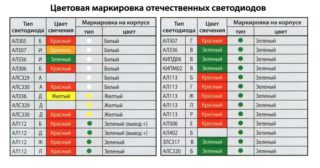 On the one hand, color marking allows you to determine the type and characteristics of the LED, on the other hand, there are no common designations. Each manufacturer uses its own values. In Russia there is color coding, but it is rarely used - the list of elements from numbers and letters is too large, difficult to remember, decryption is inconvenient for the average buyer.
On the one hand, color marking allows you to determine the type and characteristics of the LED, on the other hand, there are no common designations. Each manufacturer uses its own values. In Russia there is color coding, but it is rarely used - the list of elements from numbers and letters is too large, difficult to remember, decryption is inconvenient for the average buyer.
A simpler letter designation is accepted as generally accepted (unofficially). Used mainly for LED strips. In addition to general characteristics, they indicate the degree of protection of the element from the penetration of debris and moisture - IP and numbers from 0 to 6.
To choose a good option for replacing obsolete light bulbs, you need to find out what kind of LEDs are and set the parameters of the connected electrical network: correspondence of voltage, current, resistance.
You can’t focus on cost - brands of cheap LEDs often have overestimated parameters and use unstable materials.
